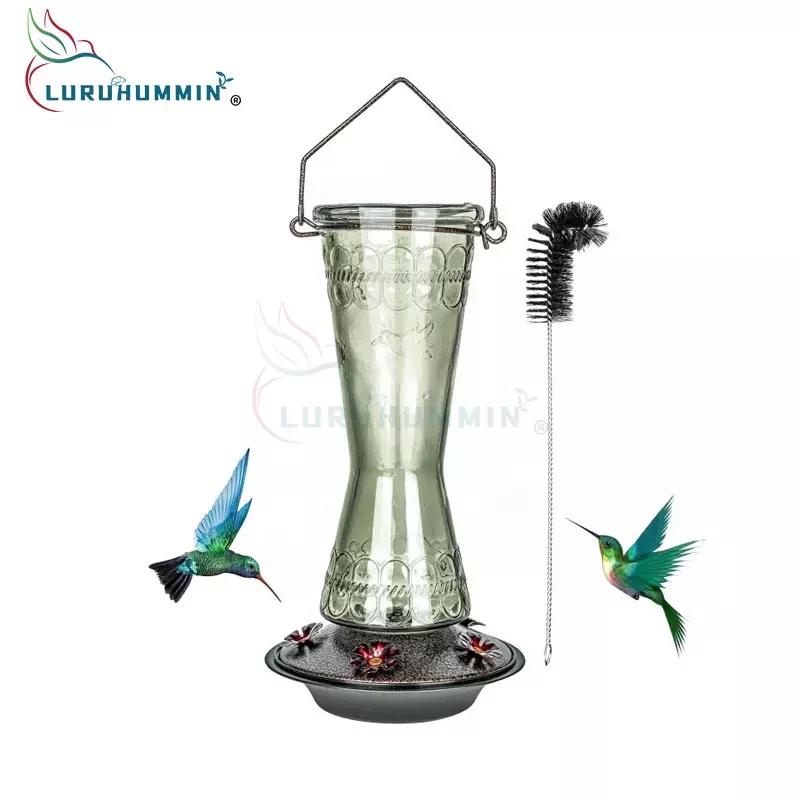How to keep bees away from hummingbird feeders?
2025-04-08
Here are some ways to keep bees away from hummingbird feeders.
Method 1: Tighten all feeder parts to prevent leaks.
If your feeder is leaking, bees will flock there. Repair the feeder if there are any leaks.
Method 2: Leave your feeder empty for 3 to 4 days.
You can confuse bees by removing the feeder for a few days. Leave it unused for at least 3 days and then put it back when the bees have migrated to the new location. Hopefully, during this time, the bees will find somewhere else to feed so your hummingbirds will be able to come and feed in peace.
This method works best when there are lots of flowering plants for the bees to gather nectar from. However, if the flowering plants have all died down over the winter, they may find your feeder again.
Method 3: Relocate the feeder to confuse the bees.
Sometimes, just moving it a few feet away is enough to deter them.
Don't worry, moving your hummingbird feeder won't confuse the hummingbirds, especially if it's not far from its original location.
Method 4: Wash your feeder with soap and water.
Try to do this once a week to avoid attracting bees. Dampen a sponge and add some dish soap, then gently wipe the feeding port and small dish. Rinse the feeder with plenty of clean water, then refill and hang it again.
A leaky hummingbird feeder attracts bees more than anything else, as they will readily sip the sweet sugar water from the side of the feeder.
Method 5: Hang your feeder in a draft-free area.
A feeder that sways in the wind may cause it to leak. These leaks may attract bees, so it's best to stop leaks before they occur. If you notice your feeder swaying in the wind, move it to a sheltered area so it doesn't move as often.
Consider placing your feeder in a covered area, such as your patio.
Method 6: Install a bee guard on your feeder.
Hummingbirds can get through, but bees can't. Snap these fences over each feeding port to keep out bees while still letting your bird sip.
Bee guards can be found at most garden supply stores.
If you have an ant problem with your hummingbird feeder, consider buying an ant moat, too.
Method 7: Give bees their own feeder.
Prepare a shallow bowl filled with sugar water so bees will fly away. Place the solution in a shallow dish and place it near your hummingbird feeder. When the bees notice a better feeding option, they will fly toward the bowl instead of the feeder.
To keep bees away from your feeder, place the shallow dish near the feeder and then gradually move it farther away each day. Eventually, you can place the bee feeder opposite your hummingbird feeder in your yard.
Method 8: Use a red feeder, not a yellow one.
Insects are attracted to the color yellow. If your hummingbird feeder is yellow, consider painting it red with nontoxic paint. Hummingbirds love the color red, but bees aren't too interested in red. If you have any yellow decorations on your feeder, you can paint them red with non-toxic paint.
You should also try to avoid adding any yellow accessories to your hummingbird feeder, like bee or ant traps.
Method 9: Dilute the mixture in your feeder.
Use a 5:1 ratio of water to sugar, rather than a 2:1 ratio. Hummingbirds won't be particularly fond of this solution, but bees will be less so. Bees prefer more sugar in their water, so they may leave to find another source. Once the bees leave, you can reuse your old hummingbird solution.
The best mixture to give hummingbirds is 4 parts water to 1 part sugar mixed without the addition of red dye.
If you're using a pre-mixed hummingbird solution, try diluting it with water.
Method 10: Keep your yard clean.
Bees are attracted to food and drink. Be sure to keep your garbage cans covered with tight lids and take old food inside to throw away. If you're outside, keep your soda and tea covered, as bees are attracted to sugar water.
Cleaning up food immediately is an excellent way to prevent most pests, not just bees.
Method 11: Avoid putting oils or creams on hummingbird feeders.
These products can harm hummingbirds. You may see recommendations on some websites for adding oil, Vicks Vapor Rub, Pam Cooking Spray, Duct Tape, Off, Skin-so-soft, or petroleum jelly to hummingbird feeders. While these products will repel bees somewhat, they can also get stuck in hummingbirds' wings, making it difficult for them to take off. In short, keep your hummingbird feeder clean to avoid harming the birds that use it.



























